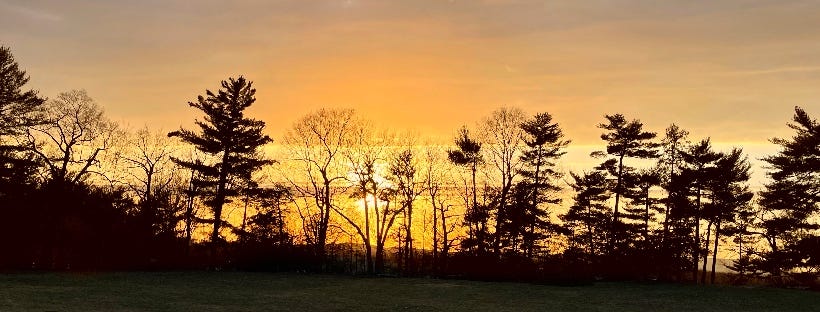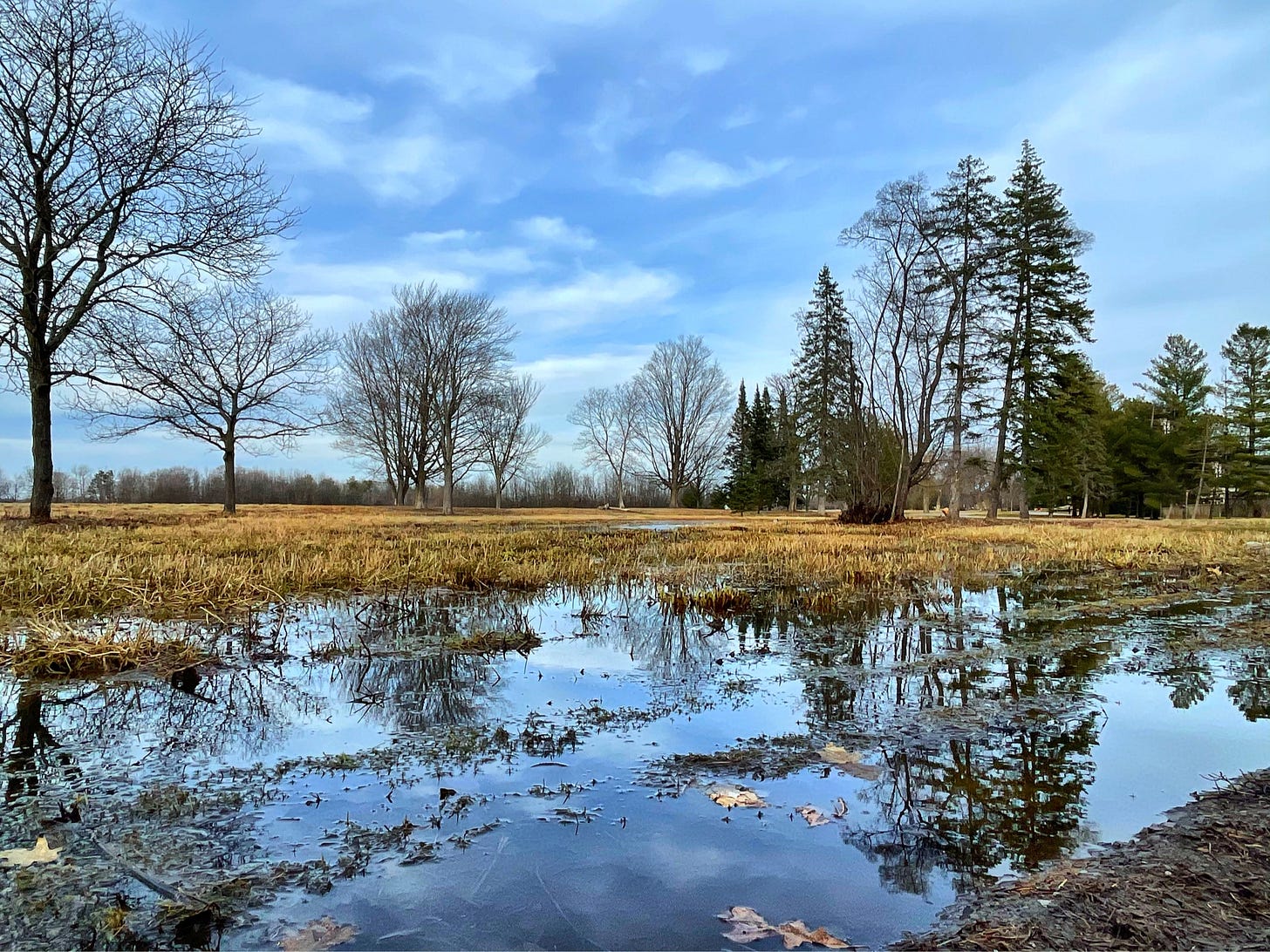I enjoyed a lovely sunset this evening while overlooking the Ottawa River. Photographers like the warm colors of the 'golden hour' at the end of the day when the last sunlight travels a longer distance through the atmosphere to reach your eye. Regular light is a mixture of all colors of the rainbow. But at sunset, the short-wavelength blue and violet tones are bounced away, leaving a warmer mix of orange and red.
Taking a picture at sunrise has a bit of this effect too, but there is a difference. Often there is less wind at night, fewer cars, or industry, resulting in fewer air particles. It often makes a morning picture brighter, sharper, and a bit less warm than a sunset picture.
I am working on several things but won't have an actual post for tonight. So you can stop here, that is what I planned to do too. But if you are curious about what else fills this page, you are welcome to browse through a mix of bits and pieces. Don't look for a coherent structure; there isn't. Take your pick at subjects that you like to read about at dinner (Asia), lunch (Europe/Africa), or breakfast (the Americas).
A few words on Substack and The Planet
I understand that quite a few of you are new at Substack, and I honestly had never heard about it until just a few weeks ago. It is good to know that besides the newsletter you receive at your email address, there is also a website.
I suppose most of you will read The Planet as a newsletter once you find it in your mail inbox. But the website offers the option to find back all previous posts I wrote. If you missed this, have a look at https://theplanet.substack.com/. That site is convenient if you recently subscribed or signed up and want to see what you have missed.
I noted that these last words are confusing. In Substack-speak, 'subscribed' is a paid subscription, and 'signed up' is for the free emails. As I wrote before, I try to keep as much content as possible free for everyone to read. Those that are willing to pay make it possible for everyone to read. Let's see if this approach works. For me, it would be the preferred option. We just passed 750 names on the email list. I am happy to see steady growth in the first two weeks. The subscriptions, well, I guess it takes a bit of time. I am delighted with each of you that supports this initiative.
If you follow other newsletters as well, you can log into the Substack Reader. You can see it as either your inbox at Substack or as your personalized page, where you find the articles of the writers you follow on Substack. It is still a beta functionality, but for me, it works fine this way. Browse around on Substack; there are many fascinating accounts to follow on all kinds of subjects.
Feed-back
Thank you for all the reactions that I daily receive—some as comments under the article, some via Twitter DMs, others via email or Instagram. Since I assume that most of you read the articles in the email version, you may have missed the comments on the website. Some could also be interesting for you to read. And since today's post is a bit of everything, I share some relevant parts of the comments and my replies.
There were quite a few reactions to the article 'How to recognize bird sounds.' Thank you to those that sent screenshots of the birds that they had discovered.
On 'The Suez Canal before the Ever Given’:
Comment: The Suez Canal plays a surprising role in Canadian political history. In 1956, a diplomat, Lester B. Pearson was central in defusing an international conflict by convincing the UN to establish their first "Peacekeeping Force". Eventually this led to his Nobel Peace Prize and to the job of Prime Minister of Canada. Of course the details are a lot messier than our national memory of the events. A good summary (and much more detail) is available here: http://www.suezcrisis.ca/summary.html.
Thank you. The Suez crisis is always fascinating reading and not to be missed by anyone interested in international relations. It is an interesting article, and I hope many will read it. Lester Pearson received the Nobel Peace Prize for his work. Many years later, in the late 1990s, I have worked intensively with many Canadians that were leading the worldwide efforts to rid the world of Landmines. I have always been impressed how Canadian diplomacy, in very close cooperation with the NGOs of the ICBL, was so effective that it led to the Ottawa Convention to ban landmines. As you know, the ICBL and Jody Williams received the Nobel Peace Prize for their work. Now that I moved to Canada some 20 years later, I loved it that I immediately received invitations to meet my Canadian friends from those days.
On 'Three things to watch and read on Sunday'
Comment: I loved reading the progression and rationale behind the logo. So many people just make a pretty icon with little thought to typography or sense. I pass a sign most days for "Half Moon Interiors" their logo depicts a crescent moon.
Glad that you like it. Have you noticed the relationship between a 'crescent moon' and a 'croissant'? It is not a coincidence. When I lived in Vienna, I often passed the place where the Viennese stopped the Ottoman Turks during Vienna's siege. It was there that I learned the story of the croissant. After the Turkish defeat, a baker in Vienna created the croissant to celebrate this event. The idea was that anyone eating a croissant was biting the Ottoman emblem of the crescent moon. When Marie Antoinette left Austria for an unhappy future in France, she brought the croissant with her. The French prefer lighter cooking than the Austrian kitchen and perfected the croissant into the version as we know it today. Perhaps it is good that most have forgotten this story, but I do like croissants.
On yesterday's post about the first flowers:
Comment: Thanks for making me check about snowdrops and their status in Switzerland. We are allowed to pick them, but only 5. I had no idea but never had the urge to pick them either. I'm learning so much.
It seems we have a typical Dutch tolerance approach on snowdrops that we also have in place for several other natural products. It is forbidden to pick snowdrops, but it seems that you don't get in trouble if it is just a few for use at home. Rumour has it that this amount is defined as that it doesn't exceed the size of one of those tiny plastic fruit boxes for strawberries from a supermarket. Bottom line: just leave them in nature.
What I saw
I went for a run and passed this spot where the melting snow left deep puddles that reflected the trees. In the past two weeks, I found that stopping to taking a picture to share on The Planet is an excellent excuse to catch my breath. You may expect more pictures. Do let me know what kind of content you prefer in the regular posts: photos, comments on the news, history, travel, art, climate change, you name it. I got quite a list of suggestions already.
Other news
I have some articles that you may have missed but are enjoyable to read. Have a look or save them for the weekend:
Science: Pleistocene Age worms found in Arctic permafrost are alive and eating well after being defrosted some 42,000 years later.
Adventure: A Brazilian pilot working for wildcat miners escaped death when his plane went down in a remote area. He walked through the jungle for 36 days before being rescued.
Photography: For four decades, Nancy Floyd has fostered a routine around confronting aging directly. Every day since 1982, the Oregon-based photographer has taken a portrait of herself.
Sustainability: Google announced that it will start directing drivers along eco-friendly routes on the Google Maps app. It aims to propose the lowest carbon emissions route. The app will take into account factors like traffic and slopes. More here.
One year ago
On 31 March 2020, I wrote this ‘alexnote’ about… 31 March 2019. I wonder what I will write about on 31 March 2022.
That’s it for tonight. So you did get all the way to the end? Consider sharing this with a friend, or on social media. And I always welcome those that change from free emails to a subscription, I hope you will be one of them.







Loved the remarks on photography. I'm gonna try and catch the sunrise or sunset tomorrow. Might even bring my big camera. Knowing me it will more likely be the sunset.
We do like our croissants here as well (we call them Gipfeli). They are the reason it's not such a good idea to have a bakery right downstairs.
Your pictures are great and I enjoy anything on history or nature. I have even started enjoying art. Travel might be a bit difficult at the moment, but OTD stories could be doable. Also, anything you're working on and can or want to share. I'm really enjoying my lunch time newsletter. Thank you!
Of course I read through to the end. Didn’t want to miss anything. How tragic about that painter. We lost so many wonderful and creative persons through the wars. There must come a time when humans finally realize that war should never be the solution to problems. Seems not only are there creatures under the ice but there may be viruses that will affect our health. Another good reason to combat climate change.